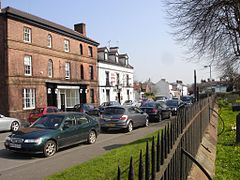Bangor-on-Dee
Bangor-on-Dee
|
|
|---|---|
 The high street in Bangor-on-Dee |
|
| Bangor-on-Dee shown within Wrexham | |
| Population | 1,110 2011 Census |
| OS grid reference | SJ388454 |
| Community |
|
| Principal area | |
| Ceremonial county | |
| Country | Wales |
| Sovereign state | United Kingdom |
| Post town | WREXHAM |
| Postcode district | LL11 |
| Dialling code | 01978 |
| Police | North Wales |
| Fire | North Wales |
| Ambulance | Welsh |
| EU Parliament | Wales |
| UK Parliament | |
| Welsh Assembly | |
Bangor-on-Dee (Welsh: Bangor-is-y-Coed or Bangor Is-Coed) is a local government community, the lowest tier of local government, part of Wrexham County Borough in Wales. It is a village in the ancient district of Maelor in Wales, situated on the banks of the River Dee. The village is in the county borough of Wrexham; until 1974 it was in the exclave of Flintshire traditionally known as the Maelor Saesneg, and from 1974 to 1996 was in the county of Clwyd.
The village and its surrounding local government community had a total population of 1,266 in 517 households at the time of the 2001 census, falling to 1,110 at the 2011 Census.
The commonly used anglicised name refers to the village's proximity to the River Dee. However, the traditional Welsh name is Bangor-is-y-Coed (or sometimes Bangor Is-Coed), literally meaning "Bangor (i.e. a settlement within a wattle fence) below the wood/trees". This form was first recorded in 1699, while an alternative name of the parish, "Bangor Monachorum" ("Bangor of the monks"), was first recorded in 1677.
A monastery was established at Bangor in about AD 560 by Saint Dunod (or Dunawd) and was an important religious centre in the 5th and 6th centuries. The monastery was destroyed in about 613 by the Anglo-Saxon king Æthelfrith of Northumbria after he defeated the Welsh armies at the Battle of Chester, which probably took place near Bangor-on-Dee; a number of the monks then transferred to Bardsey Island and appear among lists of saints. Before the battle, monks from the monastery had fasted for three days and then climbed a hill to witness the fight and pray for the success of the Welsh; they were massacred on the orders of Æthelfrith. The scholar Bede wrote that 1200 monks were slaughtered and only 50 escaped. Other accounts are very different in terms of the numbers killed and the date: the Anglo-Saxon Chronicle, for example, states that 200 priests were slain at Chester in 607. More than a millennium later, the massacre was recounted in a poem entitled "The Monks of Bangor's March" by Walter Scott, and put to music by Ludwig van Beethoven. Today no trace of the monastery remains and even its site is uncertain; it is possible that all the buildings, including the church, were built of wattle and daub.
...
Wikipedia

